 Tour Information Travel Information > Tour Information
Tour Information Travel Information > Tour Information-
Gyeongju is one of Korea's national treasures and World's important resource of culture and history. It is also the ancient capital of the so-called "Korea's Golden Kingdom", in which a vast number of archaeological sites and cultural properties from this period remain.
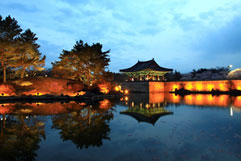 Anapji, or Anap Pond is an artificial pond in Gyeongju National Park, South Korea. It was part of the palace complex of ancient Silla (57 BCE - 935 CE). It was constructed by order of King Munmu in 674 CE. Research revealed that the pond had been surrounded by stone walls, and that 5 buildings had been standing on the pond's west to south sides. Waterway systems were also detected. Almost 33,000 pieces of historic relics were excavated from the site. An abundance of unique and extraordinarily designed roof tiles, architectural materials, pottery, gilt bronze figures of Buddha, jewelry, accessories and other everyday items were discovered, offering an insight to Buddhist art and everyday life in Silla.
Anapji, or Anap Pond is an artificial pond in Gyeongju National Park, South Korea. It was part of the palace complex of ancient Silla (57 BCE - 935 CE). It was constructed by order of King Munmu in 674 CE. Research revealed that the pond had been surrounded by stone walls, and that 5 buildings had been standing on the pond's west to south sides. Waterway systems were also detected. Almost 33,000 pieces of historic relics were excavated from the site. An abundance of unique and extraordinarily designed roof tiles, architectural materials, pottery, gilt bronze figures of Buddha, jewelry, accessories and other everyday items were discovered, offering an insight to Buddhist art and everyday life in Silla.
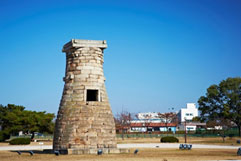 Cheomseongdae is an astronomical observatory in Gyeongju, South Korea. Cheomseongdae means star-gazing tower in Korean. Cheomseongdae is the oldest surviving observatory in East Asia. It dates to the 7th century to the time of kingdom of Silla, which had its capital in Gyeongju. It was designated as the country's 31st national treasure in 1962.
Cheomseongdae is an astronomical observatory in Gyeongju, South Korea. Cheomseongdae means star-gazing tower in Korean. Cheomseongdae is the oldest surviving observatory in East Asia. It dates to the 7th century to the time of kingdom of Silla, which had its capital in Gyeongju. It was designated as the country's 31st national treasure in 1962.
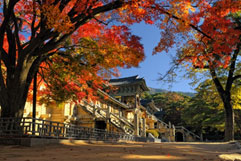 Bulguksa is a head temple of the Jogye Order of Korean Buddhism and encompasses seven National treasures of South Korea, including Dabotap and Seokgatap stone pagodas, Cheongun-gyo (Blue Cloud Bridge), and two gilt-bronze statues of Buddha. The temple is classified as Historic and Scenic Site No. 1 by the South Korean government.[1] In 1995, Bulguksa was added to the UNESCO World Heritage List together with the Seokguram Grotto, which lies four kilometers to the east. The temple is considered as a masterpiece of the golden age of Buddhist art in the Silla kingdom.[citation needed] It is currently the head temple of the 11th district of the Jogye Order of Korean Buddhism.
Bulguksa is a head temple of the Jogye Order of Korean Buddhism and encompasses seven National treasures of South Korea, including Dabotap and Seokgatap stone pagodas, Cheongun-gyo (Blue Cloud Bridge), and two gilt-bronze statues of Buddha. The temple is classified as Historic and Scenic Site No. 1 by the South Korean government.[1] In 1995, Bulguksa was added to the UNESCO World Heritage List together with the Seokguram Grotto, which lies four kilometers to the east. The temple is considered as a masterpiece of the golden age of Buddhist art in the Silla kingdom.[citation needed] It is currently the head temple of the 11th district of the Jogye Order of Korean Buddhism.
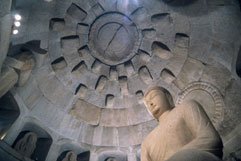 The Seokguram Grotto is a hermitage and part of the Bulguksa temple complex. It lies four kilometers east of the temple on Mt. Tohamsan, in Gyeongju, South Korea. It is classified as National Treasure No. 24 by the South Korean government and is located at 994, Jinhyeon-dong, Gyeongju-si, Gyeongsanbuk-do. The grotto overlooks the Sea of Japan (East Sea) and rests 750 meters above sea level. In 1962, it was designated the 24th national treasure of Korea. In 1995, Seokguram was added to the UNESCO World Heritage List together with the Bulguksa Temple. It exemplifies some of the best Buddhist sculptures in the world.
The Seokguram Grotto is a hermitage and part of the Bulguksa temple complex. It lies four kilometers east of the temple on Mt. Tohamsan, in Gyeongju, South Korea. It is classified as National Treasure No. 24 by the South Korean government and is located at 994, Jinhyeon-dong, Gyeongju-si, Gyeongsanbuk-do. The grotto overlooks the Sea of Japan (East Sea) and rests 750 meters above sea level. In 1962, it was designated the 24th national treasure of Korea. In 1995, Seokguram was added to the UNESCO World Heritage List together with the Bulguksa Temple. It exemplifies some of the best Buddhist sculptures in the world.
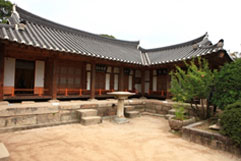 The ancestral home of the Choi familyis right next to Namcheon. The original form of Choseon Yangban architectural style is completely preserved in this home.
It is a highly culturally valuable. The house used to have 99 rooms and covered up 6,600 M2 and the back garden alone covered 33,000 M2. Nowadays we can only see the square shape of the main building with the guest house that has been recently rebuilt after it was burned down in the 1970s. The current building stands on what used to be Yoseok Palace where Princess Yoseok used to live. Princess Yoseok fell in love with Wonhyo (a famous Buddhist monk and scholar) and gave birth to Seolchong (a famous monk and scholar). The Choi family in the mid Chosen Dynasty.
The ancestral home of the Choi familyis right next to Namcheon. The original form of Choseon Yangban architectural style is completely preserved in this home.
It is a highly culturally valuable. The house used to have 99 rooms and covered up 6,600 M2 and the back garden alone covered 33,000 M2. Nowadays we can only see the square shape of the main building with the guest house that has been recently rebuilt after it was burned down in the 1970s. The current building stands on what used to be Yoseok Palace where Princess Yoseok used to live. Princess Yoseok fell in love with Wonhyo (a famous Buddhist monk and scholar) and gave birth to Seolchong (a famous monk and scholar). The Choi family in the mid Chosen Dynasty.










